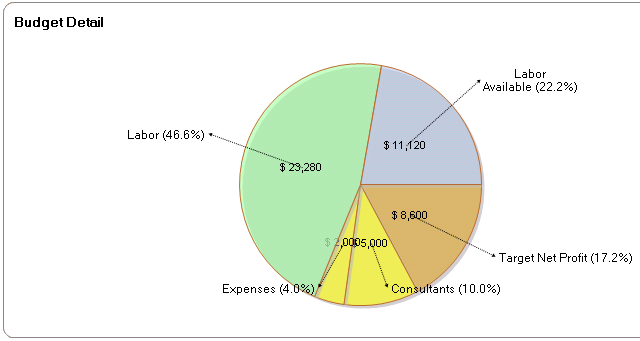Labor Budget Tab
TheLabor Budget tab is used by the project manager to define a high-level, top-down labor budget, allocating the available remaining budget to each phase and discipline. Fees minus target income, consultants, and non-reimbursables results in available labor dollars or the project labor. The budget is built against available dollars.
If you have made updates to the Team tab, you must use the Load Labor from Team tool found in Labor Budget ribbon bar section to import the updated information to theLabor Budgettab.
Chart: Budget Detail

The total value of the pie chart represents all active fees on the Contract / Fees tab and shows how the total project gross fees break down to arrive at available labor and overhead. As assignments are populated in the grid, the chart is updated. The following pieces are included:
Resize the chart to improve readability.
Status
The status for the phase. The following statuses are available:
Phase
The name of the phase. Only phases with an assigned schedule can be budgeted. The available phase names are obtained from the accounting system.
If the Lock by Date button in the Labor Budget ribbon is active, phases that are done cannot be modified.
Budget | %
Displays the total amount budgeted for the phase across all disciplines. The percentage shown is the percentage of the total budget this amount represents. Both of these columns are read-only and automatically update as dollars or hours are allocated to each discipline.
Team Complete
Displays the percent complete of the assignments from the Team tab for all assignments in the phase.
When detailed staffing is assigned, Team Complete is calculated using the detailed work plan data, instead of assuming an even distribution of hours over the weeks of the assignment. For additional details, please refer to ETC Hours on the Team tab.
Team ETC
This value represents the amount of planned labor dollars remaining for the project. When detailed staffing is assigned, TeamETC (Estimated to Complete) is calculated using the detailed work plan data, instead of assuming an even distribution of hours over the weeks of the assignment. For example, if an assignment spans five weeks but has 90% of its hours in the last two weeks, the TeamETC is 90% of the total cost.
When detailed staffing is assigned, Team ETC is calculated using the detailed work plan data, instead of assuming an even distribution of hours over the weeks of the assignment. For additional details, please refer to ETC Staffing on the Team Tab.
Schedule ETC
Displays the ETC (estimated to complete) budgeted labor remaining to complete the phase based on the number of days for the phase duration. To calculate the Schedule ETC, Project Analyzer assumes that an equal percent of the planned labor is completed for each day of the phase duration. For example, if a phase is 100 days long and the current day is day 50, Schedule ETC is calculated assuming that 50% of the work for the phase is complete. The sum of the ScheduleETC column is represented in the Budget Detailchart as Labor.
If the Schedule ETC exceeds the available staffing, the amount of Schedule ETC that exceeds the available budget is represented in the Budget Detail chart as Labor Over Budget. The total of the Labor and Labor Over Budget pieces of the pie chart equal the ScheduleETC Staffing column total.
For additional information on how the Team ETC and Schedule ETC differ, please refer to ETC Definition.
Discipline columns
Each discipline is represented by a column displaying the labor budgeted per discipline for the phase in either dollars and/or hours. The dollars and hours columns can be toggled on/off by using the Show Hours and Show Dollars buttons in the Labor Budget section of the ribbon bar. When both options are selected, an hours column and a dollars column appears in the grid for each discipline. When either value is entered the corresponding value is updated automatically.
Hover over the column headers to view the current cost rate for each discipline.
The disciplines available are obtained from your accounting system based on the settings made in the Newforma Project Analyzer Connection Manager.
When you manually update the hours for a discipline on the Labor Budget tab, the dollars for the discipline are recalculated using the blended discipline rate.
Hours
Displays the total hours budgeted for the phase across all disciplines.
The field name appears as Total Hours in the field chooser.
People
The number of full time equivalents (FTEs) budgeted for the phase.
FTEs values are shown to two decimal points.
Additional Columns
The field chooser contains additional columns which may be added to the grid. For the Labor Budget tab these include:
Project Analyzer assumes that an equal percent of the planned labor is completed for each day of the phase duration. For example, if a phase is 100 days long and the current day is day 50, Schedule Complete is 50%.
Current Plan tab
The Current Plan tab displays the current state of the labor budget for the project. You can save the data as the baseline for the labor budget for this project at anytime by selecting Save as Baseline from the Labor Budget section of the ribbon bar.
Throughout the life of the project, compare to the current values to the baseline using the Time Analysis tab.
Baseline tab
The Baseline tab displays the last saved baseline values for the project's labor budget. For more information on changing the baseline, see the topic titled Create a Labor Budget Baseline.
The baseline can be changed throughout the project so long as the project budget status is not Approved.
Hover over the Baseline tab to see who last edited the baseline values and when it was edited.
If the baseline ins empty, it is created the first time you save the labor budget.
Related Topics
To access this tab
Click the Labor Budget tab in the main Project Analyzer window.